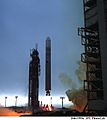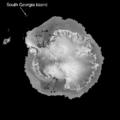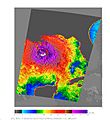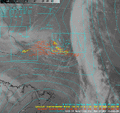QuikSCAT facts for kids
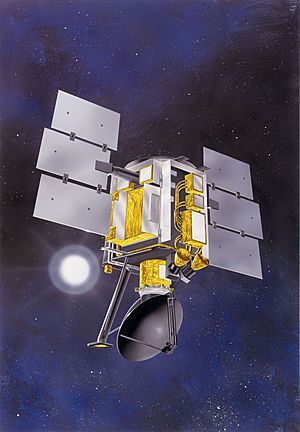 QuikSCAT |
|
| Organization | JPL, NASA |
|---|---|
| Mission Type | Earth observation |
| Contractor | Ball Aerospace & Technologies Corp. |
| Satellite of | Earth |
| Launch | June 19, 1999 on a Titan II |
| Launch site | Vandenberg Air Force Base |
| Mission duration | 2–3 years |
| Mass | 971 kg (launch) |
| Webpage | winds.jpl.nasa.gov/missions/quikscat/ |
| Orbital elements | |
| Semimajor Axis | 7180.8 km |
| Eccentricity | 0.00014 |
| Inclination | 98.6 degrees |
| Orbital Period | 100.93 minutes |
| Right ascension of the ascending node | 178.47 degrees |
| Argument of perigee | 47.4 degrees |
| Instruments | |
| SeaWinds | microwave radar that measures near-surface wind speed and direction |
The QuikSCAT (Quick Scatterometer) is an earth-observing satellite that provides wind speed and direction information over oceans to NOAA. It is a "quick recovery" mission to fill the gap created by the loss of data from the NASA Scatterometer (NSCAT) that was lost in June 1997. It is in a sun-synchronous low-earth orbit.
Because of the 2003 failure of the ADEOS II satellite that was meant to succeed the NSCAT, QuickSCAT is currently the only US-owned instrument in orbit that measures surface winds over the oceans. The European Space Agency has its own scatterometers in orbit, such as Envisat.
However, because it is now running on a backup transmitter and having other problems, this satellite could fail at any moment, putting risk at weather forecasts for possibly dangerous tropical cyclones.
In early June 2007, Bill Proenza, Director of the National Hurricane Center in Florida, came under fire for criticizing his NOAA superiors for not creating a back-up plan for replacing the capabilities provided by this satellite.
Images for kids
-
QuikSCAT image of Hurricane Katrina on August 28, 2005 over the Gulf of Mexico
See also
 In Spanish: QuikSCAT para niños
In Spanish: QuikSCAT para niños


